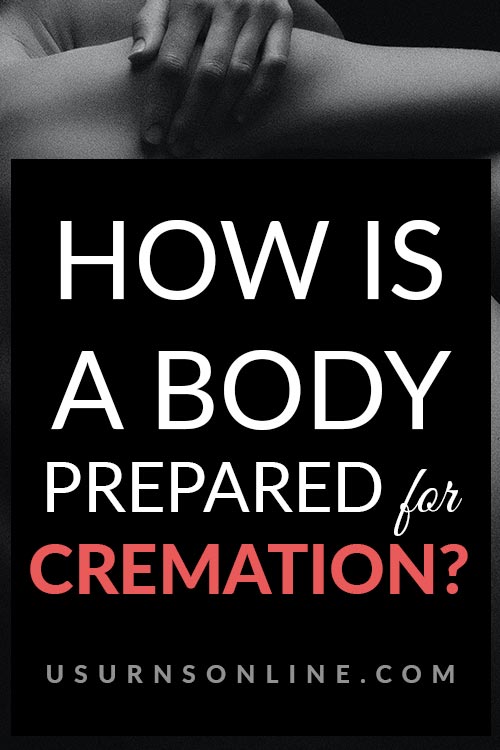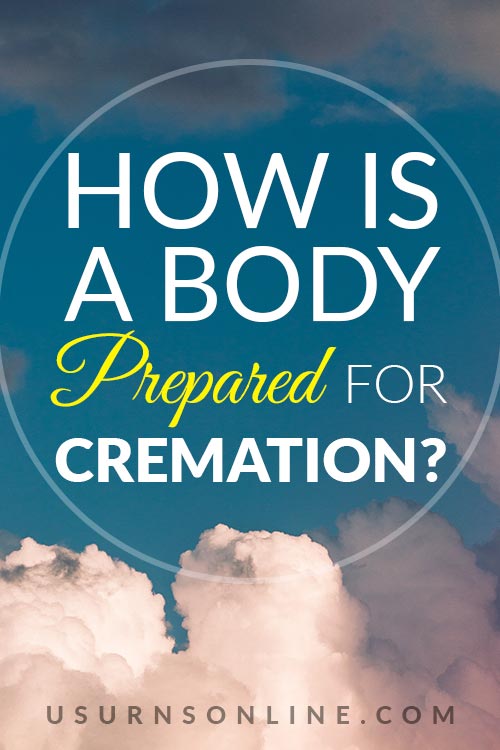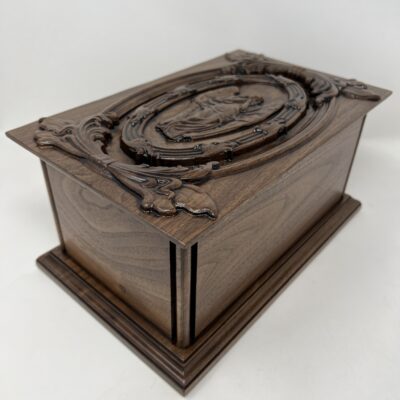How do they prepare a body for cremation?
This is a frequent question people have when a loved one has died and they chose cremation.
Once the funeral home has picked up the body, what happens? How long until the cremation takes place? Where will your loved one be until the cremation occurs? Does the body have to be embalmed?
Cremation can be a source of contention within families. In my experience as a funeral director, it is best to follow the decedent’s wishes, even if you disagree with them.
People have so many questions at this time. I will do my best to answer these questions and more.
Continue reading and you will learn the mysteries of cremation.
How Is a Body Prepared for Cremation?
Body preparation depends on a couple of factors.
- Will there be a viewing? If so, is it
- An ID viewing or
- A public viewing?
- Is this a direct cremation?
We will be discussing each of these points and more below. The best way to explain is to simply dive in.
Here’s how the body is prepared for cremation, from start to finish.
1. Funeral home picks up the body
Once the death has taken place, you will call the funeral home of your choice. The funeral home will usually arrive within an hour’s time.
Urns Made in the USA
The “removal team” will transport the body back to the funeral home. The team will place the body in refrigeration or in the prep room.
2. Funeral is planned
The family will meet with the funeral director to plan any service. We try to get the family to come in the next day, if possible.
By this time, the decedent is in a refrigeration unit. Typically the unit will keep the body between 36-39 degrees Fahrenheit. This will slow down decomposition. If you have decided on a direct cremation, the body will stay refrigerated until the cremation takes place.
If you have requested embalming or are having a public viewing, the body will be removed from the cooler and placed in the prep room.
3. Embalming is optional
If you have requested a public viewing, the embalming procedure will be performed.
Embalming is an optional service in which the decedent’s bodily fluids are removed and replaced with preserving agents. This helps ensure your loved one looks their best for the viewing.
The Federal Trade Commission says: “Embalming may be necessary if you select certain funeral arrangements such as a service with public viewing. If you do not want embalming, you usually have the right to choose an arrangement that does not require you to pay for it, such as direct cremation or immediate burial.”
In other words, embalming is not mandatory, but the funeral home may require it with certain service options.
4. Preparing the body for cremation
The funeral director will remove all jewelry from the body and return it to the family. The director will also remove any pacemakers and ICDs.
If the family has chosen a direct cremation, there is no further preparation. The body will be cremated “as is.”
If the family has chosen a public viewing, embalming will be performed. When the embalmer has finished, the body will be bathed, dried, dressed, and casketed. Your loved one is ready for viewing.
5. Identity is verified
A family member will sign an “ID Verification Form” at the time of removal. This form states that the body being removed is their loved one. You won’t have to make any further identification.
There are times when a family will want to have an “ID viewing.” This is considered a private viewing. The funeral home usually allows only the next of kin to view. An ID viewing is usually used when there is no family present at the time of death.
Cosmeticizing and embalming will not be performed for ID viewings. The deceased is cleaned and placed on a table. The body will be covered with a sheet or blanket with the face shown. An ID viewing is truly meant for identification only.
Depending on the deceased’s condition at the time of death, some people may find this viewing disturbing. I have always given the family a frank description of the body beforehand. I have, on occasion, advised against a viewing. It is not recommended to view if there has been a disfiguring accident or serious decomposition.
There may be some additional documents signed by the family. This might happen immediately after death, during the planning stages, or right before the cremation takes place. Each facility and state has different procedures, which your funeral director will walk you through.
6. Body is ready for cremation
Once the family has signed all appropriate documents and the cremation permit has been received from the state, the preparation will continue.
All jewelry has been removed and returned to the family. Pacemakers and ICDs (implantable cardioverter-defibrillator) have been removed from the body. Pacemakers and ICD’s are taken to avoid the risk of explosion during cremation.
The final step prior to cremation is to place the body in a suitable cremation container.
The container will be one of the following:
- Alternative Container: A heavy-duty corrugated cardboard box; designed for the encasement of human remains.
- Cremation Casket: A solid wood casket designed for cremation.
7. Cremation begins
The body is placed into the container and moved to the retort (a.k.a., the cremation chamber). The chamber will heat up anywhere from 1400-2000 degrees Fahrenheit.
The cremation process itself takes about 2 hours. If you would like to witness the cremation, arrange it beforehand. If this option is available to you, a few close family members will be able to watch the final preparations and the body being placed into the cremation chamber. The family will stay to watch for a few minutes and then leave.
The crematory operator will remove the cremated remains from the chamber. He will check for any remaining metal. The metal that could be remaining would be from surgical staples, pins, or artificial joints. The crematory operator will remove the metal from the cremated remains with a high-powered magnet.
8. Remains are cooled & processed
The cooling process of the cremated remains will take around an hour. After the cremains have cooled, they will be processed.
A machine will process the cremated remains. The processor grinds the bones into a powder-like consistency. The cremated remains are mostly bone fragments, along with any residue left from the cremation container.
People also call cremated remains cremains or ashes. Personally, I don’t like the word “ashes.” I find it disrespectful. “Cremains” is also falling out of favor; most industry professionals use “cremated remains” or simply “remains.” However, you will still often hear people speak of “ashes” (especially in their internet searches) and so that term is regularly used on this website.
Additional resource: The Cremation Process: How Does Cremation Work?
9. Cremated remains are returned to you
The cremated remains will be placed in an urn of your choice once they have been processed. You can choose an urn from the funeral home or visit our online store at Urns Northwest.
I always encourage a family to follow their loved one’s wishes when it comes to burying, scattering, or keeping the cremated remains. If you can’t bear to part with all of the cremains, save a small amount in a keepsake urn or cremation jewelry.
Related: 27 Things to Do with Cremated Remains
Preparing for Cremation FAQs
These are a few questions that most families ask.
How long does it take to prepare a body for cremation?
Once the body is in the crematory, the funeral director will check for jewelry; she will remove it and return it to the family. The funeral director will also be checking for a pacemaker or ICD. The director will remove these devices upon detection.
These tasks don’t take too much time to complete.
There is usually at least a 24-hour waiting period after death before the deceased can be cremated. In some states, the laws on cremation state that 48-hours must lapse between death and cremation.
Related Resource: How Long After Death Is a Funeral Held?
The crematory operator must consider: Are all forms ready and signed? Has the funeral home obeyed the state laws? If the answer is “Yes,” then cremation can take place.
For more information on timing and planning the cremation, see our Cremation Timeline.
Do you have clothes on when you are cremated?
Direct cremation services do not include viewings or dressing. The decedent will be cremated in either a sheet or the clothing they are wearing upon arrival to the crematory.
The family can provide clothing for the decedent. Usually, the clothing will be cremated along with the body. The family might request the return of the clothing, especially after a public viewing. The family may have given the funeral director something they don’t want to have cremated: a cowboy hat, jewelry, a pair of boots, or a belt.
There have been times I have given all the clothing back to the family. It is their decision to make. Whatever the family wants, please don’t be judgmental. If you’re a family member with a request, don’t be afraid to make it known to your funeral director. They’re available to help.
What clothes should the body have on for cremation?
Cremation can take place in just about any clothing. Some synthetic fabrics may contain toxins that are hazardous to burn. Natural fabrics such as wool, linen, or cotton are ideal.
I have seen cremations take place with people dressed in their Sunday best or their favorite pajamas. It is a choice the decedent may have made long before their death.
You cannot cremate anything illegal or explosive, glass, some plastics, rubber soled shoes, and some synthetic clothes.
Does a body get drained before cremation?
A direct cremation does not require embalming. The body fluids will not drained.
If you chose embalming, the blood and body fluids will be drained and replaced by embalming fluids and chemicals.
Are fillings, crowns, and surgical pins removed before cremation?
No. Fillings and surgical pins remain in the body.
The fillings and crowns are very small and will incinerate. After the cremation has taken place, the pins will be removed with a magnet.
How many bodies are cremated at one time?
The cremation takes place with only one body in the chamber. And you can rest assured when you receive the cremated remains back that those cremains are your loved one.
The crematory and the funeral home have stringent guidelines to follow. The funeral home will use the identification provided by the facility or place of death. The funeral director will attach a wrist band on the body before leaving the facility or place of death. Additionally, the family provides a photograph for visual identification and signs an ID Verification form.
The crematory operator will compare all of the paperwork with the ID bands on the body. He will place a uniquely numbered metal identification disk with your loved one. The operator will place the ID disk in the cremation chamber with the body. He will compare the photo to your loved one’s face.
When – and only when – the operator has completed the ID, the cremation will proceed.
The funeral director and the crematory operator complete this identification process with every single cremation.
There can be no mistakes when it comes to cremation. Cremation is irreversible.
How long does it take to cremate a body?
The actual cremation can take about 2- 3 hours, cooling and processing the cremated remains takes another 1-2 hours. A total of 5-6 hours from start to finish is about average.
Of course, the crematorium is often busy and it may take some time after the cremation and cooling before the remains are processed. Additionally, the funeral home has to arrange transportation back and forth, and perhaps arrange the urn (unless you get a beautiful cremation urn from us).
So don’t be surprised if they tell you it will take several days or even a week to get the remains back to you. In addition to cremation, the staff is answering phone calls, processing paperwork, meeting with families, helping with funerals and burials, and much more.
If you still have questions, we’ve answered many more just like these here: 25 Weird Questions People Always Ask About Cremation.






I found this information very through and informative. Thank you so much. VG of Sarasota, Fl.
Excellent article, very informative, thank you!
Thank you so much for helping me to decide on how I want to be taken care of when my heavenly Father sends me my special wings that he has prepared for my flight home to his waiting arms.
I now know that it is actually less stressful to be cremated than to be buried in the ground. So I will be leaving instructions for my body to be cremated with no viewing service since I have no family left to view my body.
Thank you for all your help and may God bless you and your loved ones.
Thank you so much for helping me to decide on how I want to be taken care of when my heavenly Father sends me my special wings that he has prepared for my flight home to his waiting arms.
I now know that it is actually less stressful to be cremated than to be buried in the ground. So I will be leaving instructions for my body to be cremated with no viewing service since I have no family left to view my body.
Thank you for all your help and may God bless you and your loved ones.
Very much relieved after reading this information on this process of cremation. Thank you for this!
This information has been very helpful this way no expense or squabbles
This has been very very helpful thank you
This has been very informative. Thank you.
This information is very helpful because I’m thinking about getting cremated
I wasn’t aware of the cremation process.
This article was very informative and has answered so many questions that I had prior to reading this article.
I thank you for the information.
I’m considering cremation with a celebration of life afterwards.
Thanks again.
God Bless